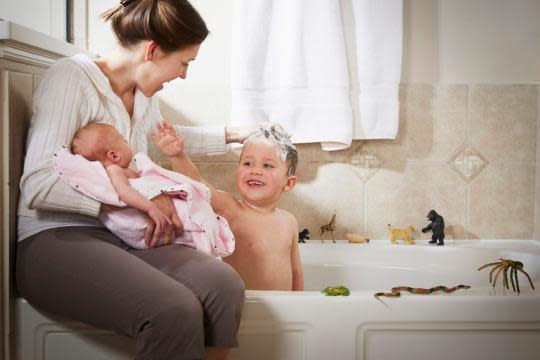How Spacing Your Pregnancies Can Be a Factor in Autism

Autism strikes 1 in 68 kids, and a new study has uncovered one factor that appears to play a role. (Photo: Corbis Images)
How far apart to space your kids depends on many things: your health, your work schedule, and whether you want your kids to be buddies close in age or grow up in separate stages. Now another factor might come into play: the risk of autism.
STUDY: The Type of Parent Most Likely to Have a Child With Autism
A new study found a link between the number of years between first-and second-born siblings and the odds that the latter child is diagnosed with an autism spectrum disorder (ASD), which affects 1 in 68 children in the U.S., according to the Centers for Disease Control.
Second-born kids who came into the world less than two years after the first child was born were 1.5 to 3 times more likely to develop ASD, and siblings spaced six or more years apart also had an increased autism risk, according to the study, published Sept. 14 in the journal Pediatrics.
STUDY: What It’s Really Like to Have a Child With Autism
The study looked at about 45,000 kids born at Kaiser Permanente Northern California hospital between 2000 and 2008. Researchers found that 1.2 percent of the second-borns, or 577 kids total, were diagnosed with ASD: 117 had Asperger’s disorder, 377 had autism, and 53 had autistic disorders that weren’t specified.
Overall, the risk of ASD was 1.5 to 3 times higher for the kids spaced less than two years apart — or had six or more years between them. “That means if roughly one in 100 kids are born with autism, the odds jump to up to three in 100,” study coauthor Lisa Croen, Ph.D., director of the Kaiser Permanente Autism Research Program in Oakland, Calif., tells Yahoo Parenting.
Interestingly, the study results are consistent with the World Health Organization’s recommendation that parents space their kids at least two years apart, to prevent low birth weight, preterm delivery, and other health issues. “Our findings fit right in with this,” says Croen.
The study showed a correlation between pregnancy spacing and autism risk; it didn’t explain the reason for the link. One theory the researchers did consider was a mom’s BMI: Both maternal obesity and excess pregnancy weight gain have been reported to moderately boost the likelihood of ASD, says Croen.
Parental age has also been associated with a higher ASD risk in previous studies. But the new study controlled for both maternal BMI and the mother and father’s age, and the results still demonstrated a higher autism risk, says Croen.
Of course, if you can’t have your kids three to five years apart, or you’ve already given birth at shorter or longer intervals, that doesn’t mean you’ve destined your second-born to having ASD. “Autism is a complex disorder with many factors and manifestations, and it would be wrong to conclude that spacing is the only thing that matters,” says Croen.
Please follow @YahooParenting on Facebook, Twitter, Instagram, and Pinterest. Have an interesting story to share about your family? Email us at YParenting (at) Yahoo.com.

